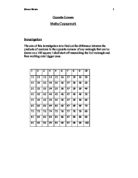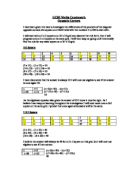- 85 x 77 = 6545
75 x 87 = 6525
20
Yes, it appears my prediction is correct. All 2x3 rectangles on the grid have a difference of 20.
However what if the rectangle is aligned differently on the grid, so the shorted sides are at the top and bottom? Will the difference for that still be 20?
- 46 x 65 = 2990
45 x 66 = 2970
20
Nope, it is still 20.
I will now try rectangles with the same height of two, but different lengths.
2 x 4
1. 77 x 84 = 6468
74 x 87 = 6438
30
2 x 5
1. 78 x 84 = 6552
74 x 88 = 6512
40
It appears that every time I increase the width by one, the difference increases by ten.
So in light of this I predict that the difference for a 2 x 6 rectangle will be 50.
2 x 6
1. 79 x 84 = 6636
74 x 89 = 6586
50
My prediction is correct.
From these results I can draw a table
The area increases by 2 each time. This is because the length is always being multiplied by the height of 2.
The difference increases by 10 each time, also each line of the grid is 10 squares wide so the next square vertically straight down is ten more than the square above it.
I can now think of some possible formulas.
L=length H=Height D=Difference
L – 1 X 10
The length subtracted by one multiplied by ten
Or
L – 1 X 5H
The length subtracted by one multiplied by five multiplied by the height.
The lowest corner subtracted from the highest corner subtracted by one, but only when the rectangle is aligned so that the shortest sides are at the top and base.
I shall now proceed to test these formulas on other rectangles, where the length will be three squares instead of two. This will help me test whether the above formulas are true for all rectangles of any shape.
3 x 3
1. 3 x 21 = 63
1 x 23 = 23
40
3 x 4
1. 4 x 21 = 84
1 x 24 = 24
60
Now the difference increases in multiples of 20.
I predict 3 x 5 will have a difference of 80.
3 x 5
1. 5 x 21 = 105
1 x 25 = 25
80
I now have enough results to build a second table.
From this I can tell that the L – 1 X 5H formula does not apply although
L - 1 X 20 does.
I believe that L-1 is correct but I still need to find how H can be used to calculate what to multiply L-1 by.
For 2 x X L-1 x 10
For 3 x X L-1 x 20
Could the rule be: Difference = L-1 x 10 x (H-1)?
Subtract one from the length, multiply by 10 and then multiply by the height subtracted by one?
I shall try testing this rule, on rectangles with a length of four, to see if this rule truly does work on all rectangles.
4 x 5
1. 5 x 31 = 155
1 x 35 = 35
120
4 x 6
1. 6 x 31 = 186
1 x 36 = 36
150
The difference is advancing by 30. 4 x 7 will have a difference of 180.
4 x 7
1. 7 x 31 = 217
1 x 37 = 37
180
My prediction is right.
However does the rue actually work?
Evaluation
I believe I have completed my aims and succeeded in attaining the goals I set myself. I have found the rule to work out the difference for any rectangle of any size on a 10 x 10 grid.
I have succeeded in doing this through extensive investigation on the various sized of different rectangles and come to the conclusion that that the Difference between the products of the numbers in the opposite corners of any rectangle = L-1 x 10 x (H-1) formula works flawlessly.









